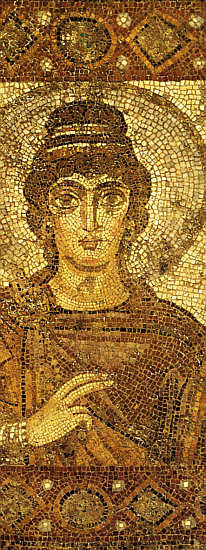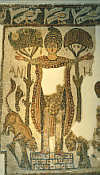|
The
2009 Baden-Württemberg major state exhibition: Cultivated
barbarians in Karlsruhe: "The heirs of the Northern
African empire - the kingdom of the Vandals
Badisches Landesmuseum Karlsruhe - Palace 24 October 2009 - 21 February 2010
 "The heirs of the Northern
African empire - the kingdom of the Vandals" is the
title of the major state exhibition presented this year
by the Badisches Landesmuseum Karlsruhe from 24 October
2009 to 21 February 2010. The rise and flourishing of the
Vandal kingdom is depicted within an exhibition space of
some 1000m2, presenting a new image of the culture and
history of northern Africa during Late Antiquity and the
Vandal epoch. This depiction contradicts the poor reputation
of the Vandals by showing that the Germanic people lived
in a civilised state. This theory is further illustrated
by over 500 exhibition objects from internationally renowned
museums, most notably the Tunisian state cultural ministry,
the Institut national du patrimoine (INP), which generously
lent over 300 items. "The heirs of the Northern
African empire - the kingdom of the Vandals" is the
title of the major state exhibition presented this year
by the Badisches Landesmuseum Karlsruhe from 24 October
2009 to 21 February 2010. The rise and flourishing of the
Vandal kingdom is depicted within an exhibition space of
some 1000m2, presenting a new image of the culture and
history of northern Africa during Late Antiquity and the
Vandal epoch. This depiction contradicts the poor reputation
of the Vandals by showing that the Germanic people lived
in a civilised state. This theory is further illustrated
by over 500 exhibition objects from internationally renowned
museums, most notably the Tunisian state cultural ministry,
the Institut national du patrimoine (INP), which generously
lent over 300 items.
Who were the Vandals? According to Roman chronicler Hydiatus,
an era ended on 19 October 439 in the northern African
province of the Roman Empire when the Vandals conquered
Carthage. In their search for new areas to settle, they
had come to Africa ten years prior. Their rule lasted for
less than 100 years because they were defeated by the army
of the Eastern Roman emperor. The exhibition tells the
story of the Vandals in seven phases and provides background
Information about the late Roman Empire, the origins of
the Vandals and their wanderings, including their migration
to northern Africa. Other aspects of the exhibition explore
the founding of the Vandal kingdom in northern Africa,
their everyday life, their Christianity, their baptismal
and burial rites as well as the decline of their state
and subsequent rule of the Aghlabids in northern Africa.
Exhibition items of both historical and artistic significance
are on display in Karlsruhe to offer insights into Late
Antiquity and the Vandal culture in northern Africa: unique
mosaics (including the piece known as the Vandal Rider
of Carthage), a sculpture of Ganymede and priceless jewellery
from the burial site of Koudiat Zâteur demonstrate
the wealth and cultural sophistication of Romanised Vandal
upper classes. One outstanding example of Vandal art is
the mosaic known as the "Lady of Carthage/' which
is shown in Germany for the first time. Another is the
Lamta sarcophagus: a key work in early Christian art, it
bears witness to the Christianisation of the upper classes.
Evocative models, such äs one of a Late Antique villa
in Sidi Ghrib near Carthage, bring the atmosphere and architecture
of the period to life. Reproductions of the basilicas Damous
el-Karita in Carthage and Henchir el-Gousset in western
Tunisia were built expressly for the exhibition to demonstrate
early Christian church architecture with its Vandal influence.
The 2009 major state exhibition features numerous exhibition
items from Tunisia that have never before been displayed
in Germany or elsewhere in Europe. At the same time, the
accompanying catalogue has now published the latest research
in the German language. The joint project was made possible
by the cooperative endeavours of German and Tunisian scholars
as well as experts from other countries within the framework
of a 2003 agreement between the Badisches Landesmuseum
at Karlsruhe and the Institut National du Patrimoine (INP).
The INP already made major contributions to the 2005 Baden-Württemberg
major state exhibition "Hannibal ad portas - The power
and wealth of Carthage" with the objects it loaned.
The Karlsruhe exhibition "The heirs of the Northern
African empire - the kingdom of the Vandals" will
be shown at the Bardo Museum in Tunis in 2011. The museum
owns the world's largest collection of Roman mosaics and
is currently being expanded.
The exhibition at the Karlsruhe Palace will be accompanied
by a series of
presentations by famous archaeologists and historians
as well as an educational program
for children, youths and adults. Workshops and numerous
tours
will be offered, both during the week and on Weekends.
 www.vandalen2009.de www.vandalen2009.de
|

 "The heirs of the Northern
African empire - the kingdom of the Vandals" is the
title of the major state exhibition presented this year
by the Badisches Landesmuseum Karlsruhe from 24 October
2009 to 21 February 2010. The rise and flourishing of the
Vandal kingdom is depicted within an exhibition space of
some 1000m2, presenting a new image of the culture and
history of northern Africa during Late Antiquity and the
Vandal epoch. This depiction contradicts the poor reputation
of the Vandals by showing that the Germanic people lived
in a civilised state. This theory is further illustrated
by over 500 exhibition objects from internationally renowned
museums, most notably the Tunisian state cultural ministry,
the Institut national du patrimoine (INP), which generously
lent over 300 items.
"The heirs of the Northern
African empire - the kingdom of the Vandals" is the
title of the major state exhibition presented this year
by the Badisches Landesmuseum Karlsruhe from 24 October
2009 to 21 February 2010. The rise and flourishing of the
Vandal kingdom is depicted within an exhibition space of
some 1000m2, presenting a new image of the culture and
history of northern Africa during Late Antiquity and the
Vandal epoch. This depiction contradicts the poor reputation
of the Vandals by showing that the Germanic people lived
in a civilised state. This theory is further illustrated
by over 500 exhibition objects from internationally renowned
museums, most notably the Tunisian state cultural ministry,
the Institut national du patrimoine (INP), which generously
lent over 300 items.